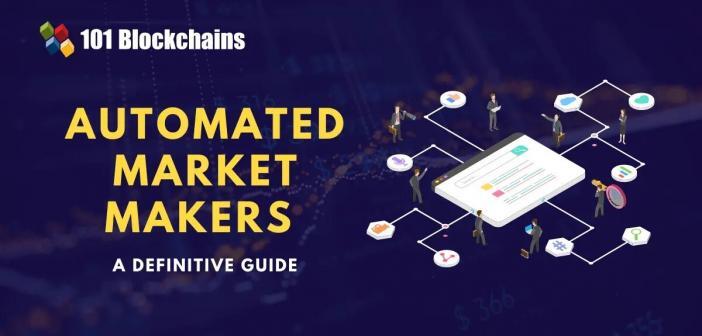Learn how blockchain truly works, master key definitions, and uncover what makes smart contracts so "smart." Dive into the fundamentals, gain valuable insights, and start your blockchain journey today!

- Guides
Diego Geroni
- on November 15, 2021
A Comprehensive Guide on Automated Market Makers
Cryptocurrency has obviously been one of the formidable technological interventions in recent times, with a specific focus on decentralization. It has introduced the possibility for executing financial transactions between two parties without any intermediaries for exchanging assets in a trustless approach. The growth of centralized exchanges such as Coinbase has been quite commendable.
At the same time, we have also witnessed the growth of decentralized exchanges. Interestingly, some platforms are running trading venues over blockchain networks and providing incentives to users for providing liquidity. Such platforms are referred to as Automated Market Makers or AMMs, which have a formidable role in an emerging DeFi ecosystem. The following discussion offers a detailed understanding of what is an automated market maker and how it works.
Build your identity as a certified blockchain expert with 101 Blockchains’ Blockchain Certifications designed to provide enhanced career prospects.
Traditional Market Makers
In order to develop an understanding of the AMM crypto connection, you need to know about conventional market makers. Market makers, in the case of traditional markets such as the ones for gold, oil, or stocks, offer liquidity to enable investors to sell or purchase assets that are close to a publicly listed price. The concept of a market maker basically focuses on matching a buyer with a seller.
It is important to ensure a match between a buy order and a sell order for the execution of a trade. You can think of such an approach as similar to that of an order book model, where all the orders sit in an order book. The order book exchange definitely presents a proven approach for global finance, which involves multiple market makers alongside many investors.
Now think of the exact scenario in the domain of cryptocurrencies. If you want to sell a token, then the traditional market maker would identify a buyer for selling the token. On the other hand, if investors want to buy a token, then the market maker should find sellers for purchasing the token. In the conventional financial industry, large financial organizations and institutions have played the role of market makers. The traditional market makers showed exceptional tolerance for risks associated with purchasing and selling assets. In order to address such risks, the traditional market makers charged a certain fee for each asset under coverage.
However, the traditional market maker process is quite time-consuming when smart contracts are involved. Therefore, Automated Market Makers is an inevitable requirement in such scenarios, without any doubt.
Want to become a Cryptocurrency expert? Enroll Now in Cryptocurrency Fundamentals Course
What is Automated Market Maker?
Now that you know what a market maker does, you might be eager to explore an account of an automated market maker explained in detail. Decentralized exchanges focus on the removal of all intermediary processes associated with crypto trading. DEXs do not provide any support for custodial infrastructures or order-matching systems.
As a result, DEX users can enjoy considerable levels of autonomy for initiating trades directly through their non-custodial wallets. However, the most interesting aspect of decentralized exchanges is the replacement of order-matching systems and the order book model with autonomous protocols known as Autonomous Market Makers or AMMs.
In the most basic sense, an AMM or automated market maker is basically a protocol, an algorithm, or a formula that helps in the pricing of assets. Rather than employing an order book model like traditional exchanges, the automated market maker algorithm helps in pricing the assets. Furthermore, you should also note that the formula for AMMs could differ for each protocol.
For example, the automated market maker formula in the case of Uniswap is “x * y = k.” In this formula, ‘x’ represents the amount of a specific token in the liquidity pool while ‘y’ represents the amount of another token in the liquidity pool. The ‘k’ in the automated market maker formula of Uniswap indicates a fixed constant in the equation. The fixed constant ‘k’ clearly suggests that the total liquidity in the pool should always stay the same.
Interestingly, you can find a different automated market maker algorithm in another AMM depending on their specific target use cases. On the other hand, all of the AMMs have a prominent similarity among them, i.e., the fact that they use algorithms for determining the prices of assets. AMMs could help in decentralizing the process of getting good prices on crypto-assets, thereby enabling any individual to create their own market on a blockchain network. Some of the notable examples of AMM crypto exchanges include Curve, Uniswap, and Balancer.
Want to get an in-depth understanding of crypto fundamentals, trading and investing strategies? Enroll now in Crypto Fundamentals, Trading And Investing Course.
Working of AMMs
The next important aspect in a guide on automated market makers explained properly refers to the working of AMMs. You should know two important aspects of AMMs before you learn about how they work.
- The trading pairs that you would normally find on a centralized exchange are found as individual ‘liquidity pools’ with AMMs.
- In addition, any individual could provide liquidity to the individual pools by depositing assets represented in the pool. For example, you must deposit a certain ratio of ETH and USDT in an ETH/USDT pool to become a liquidity provider.
Coming to the answer to “How do automated market makers work?” you should know that they work just like an order book exchange. However, the liquidity pool has trading pairs such as ETH/DAI or ETH/USDT. On the other hand, you don’t need another trader to make a transaction as you can interact with a smart contract that generates or ‘makes’ the market. In the case of decentralized exchanges such as Binance DEX, trades occur directly among user wallets.
If you are selling BNB in return for BUSD on the Binance DEX, then you have someone on the other side of the transaction who purchases BNB with the BUSD in their possession. You can refer to this as a peer-to-peer transaction. On the other hand, you can find a simple answer to “How do automated market makers work?” in the fact that AMMs are peer-to-contract or P2C.
The transactions in automated market makers do not imply the need for any counterparties as required in conventional transactions. On the other hand, the transactions in AMMs are executed between users and smart contracts. It is also interesting to note that you could not find any order types in an AMM crypto exchange due to the lack of an order book.
Excited to learn the basic and advanced concepts of ethereum technology? Enroll Now in Ethereum Technology Course
Liquidity Pool – An Important Factor
The most striking highlight about Automated Market Makers or AMMs directly refers to the fact that buyers and sellers don’t have to wait for counterparties to sell or buy crypto on DEXs. However, some agent has to take the responsibility of creating the market. You still need liquidity in the smart contract, which can enable trade on AMMs without counterparties. Liquidity providers come to the rescue by offering the liquidity desired in the smart contract.
Liquidity providers work by adding funds to liquidity pools. The liquidity pools are basically a massive pile of funds that traders could trade against. Liquidity providers can earn a certain share of fees from the trades occurring in their pool for providing liquidity in the automated market maker algorithm. As a matter of fact, liquidity providers are one of the most important aspects in answers to “How do automated market makers work?” for obvious reasons.
For example, liquidity providers in Uniswap would have to deposit the equivalent value of two tokens in the ETH/DAI pool. Therefore, it is clearly evident that any individual could become a market maker by adding funds to a liquidity pool. The automated market maker protocol determines the rewards for the liquidity providers. In the case of Uniswap v2, you can find a transaction fee worth 0.3%, which is transferred directly to liquidity providers.
Curious to understand the complete smart contract development lifecycle? Enroll in Smart Contracts Development Course Now!
Significance of Liquidity
It is also important to understand why liquidity is an important concept in the case of Automated Market Makers or AMMs. The primary way in which AMMs work is the foremost reason for emphasizing the importance of attracting liquidity. Higher levels of liquidity in the pool could ensure limited possibilities of slippage for large orders. As a result, improved liquidity could play a crucial role in driving more volume to the platform. It is also important to note that the slippage issues could be considerably different according to different AMM protocols.
The automated market maker formula helps in determining to price. The formula showcases the degree of change in the ratio between tokens in a liquidity pool after a specific transaction. In the event of a massive margin of change in the ratio, you have to worry about unreasonably high levels of slippage.
Let us assume a practical example for identifying how liquidity is important for Automated Market Makers. Suppose you want to buy all the ETH in an ETH/DAI pool on Uniswap. The best answer for you would be no, as you could never purchase all the Ether in the pool. Why? You must pay exponentially higher and higher premiums for every additional ETH you purchase from the ETH/DAI pool on Uniswap.
The primary reason for the exponentially increasing premium on every additional Ether is the automated market maker formula of Uniswap, i.e., “x * y = k.” The formula clearly suggests that the liquidity pool can never have zero ETH or zero DAI, as the equation wouldn’t make sense anymore.
Impermanent Loss – A Critical Factor
Another important factor that comes forward in different accounts of automated market maker explained clearly refers to impermanent loss. Impermanent loss is a critical aspect in the facility of liquidity for AMMs. It happens when the price ratio of the tokens you have deposited in a liquidity pool changes after you have deposited the tokens in the pool.
With a larger variation, you are likely to incur a bigger impermanent loss. Therefore, Automated Market Makers generally work effectively for token pairs that have identical values, such as wrapped tokens or stablecoins. In the event of a relatively small range of the price ratio between a token pair, the impermanent loss becomes negligible.
However, massive changes in the ratio of the token pair could imply additional concerns for liquidity providers. In such cases, liquidity providers can just hold their tokens rather than add funds to the liquidity pool. Furthermore, Uniswap pools such as ETH/DAI, which are highly vulnerable to impermanent loss, have shown prospects of profitability with the accrued trading fees.
On the other hand, the impermanent loss does not do appropriate justice for its name. Impermanence basically implies that when assets revert to the prices at which they were deposited originally, user losses are reduced. On the other hand, withdrawing your funds at a price ratio different from the one at which you deposited them could lead to more permanent losses. While trading fees could play a supporting role in mitigating the losses, the risk of impermanent loss would be important.
Want to learn the basic and advanced concepts of Stablecoin? Enroll now in Stablecoin Fundamentals Masterclass
Examples of Automated Market Maker Protocols
A discussion with an automated market maker explained properly would remain incomplete without an outline of popular AMM protocols. Here is an overview of some of the notable automated market maker protocols you could find today.
-
Uniswap

Probably the most popular automated market maker algorithm example out there now, Uniswap aims to offer an open and accessible marketplace.
Uniswap leverages AMM mechanism for the calculation of token prices according to the token ratio in liquidity pools.
-
Balancer

Balancer is another top addition among AMM crypto exchanges with exceptional similarities to Uniswap. However, it also features a broader assortment of features such as custom pool ratios, multi-token pools, and dynamic pool fees. Multi-token pools can serve as a distinct highlight with Balancer by working as an index in the domain of cryptocurrency.
-
Kyber Network

Another notable entry among Automated Market Makers in present times would refer to Kyber Network. As a matter of fact, Kyber Network is one of the oldest AMM protocols in the market. Interestingly, professional market makers take care of managing the liquidity pools of Kyber Network. Therefore, it does not depend on a specific automated market maker algorithm and could offer control of liquidity pools in event of volatility. However, Kyber Network presents some formidable restrictions on access to liquidity pools.
-
Curve Finance

You could also discover the name of Curve Finance among the top AMM protocols in present times. It is basically a decentralized exchange that focuses largely on trading stablecoins. The focus of Curve Finance on stablecoins helps it in ensuring minimal fees for trades alongside reduced concerns of slippage.
As you can notice, different types of Automated Market Makers on decentralized exchanges or DEXs have changed the ways of determining the price of crypto assets for trading. However, AMMs also come with some risks such as vulnerability of smart contracts, impermanent loss, and safety procedures.
Aspiring to build your future with Blockchain? Learn Blockchain concepts easily with 101 Blockchains flashcards.
Bottom Line
On a final note, it is clearly evident that Automated Market Makers have a crucial role in defining the foundation for the future of crypto trades. AMMs are protocols that can enable investors to purchase or sell crypto on decentralized exchanges without counterparties for the trade. Therefore, automated market maker protocols could introduce massive levels of flexibility in the domain of crypto trading. Interestingly, AMM-based exchanges present some notable differences from centralized exchanges.
For example, you have liquidity pools in a place of the trading pairs, and liquidity providers could take on the role of market makers easily. At the same time, AMM protocols also bring some risks such as impermanent loss and possibilities of compromised smart contracts. Learn more about Automated Market Maker or AMM protocols and identify new, effective approaches for trading your crypto holdings.
*Disclaimer: The article should not be taken as, and is not intended to provide any investment advice. Claims made in this article do not constitute investment advice and should not be taken as such. 101 Blockchains shall not be responsible for any loss sustained by any person who relies on this article. Do your own research!





